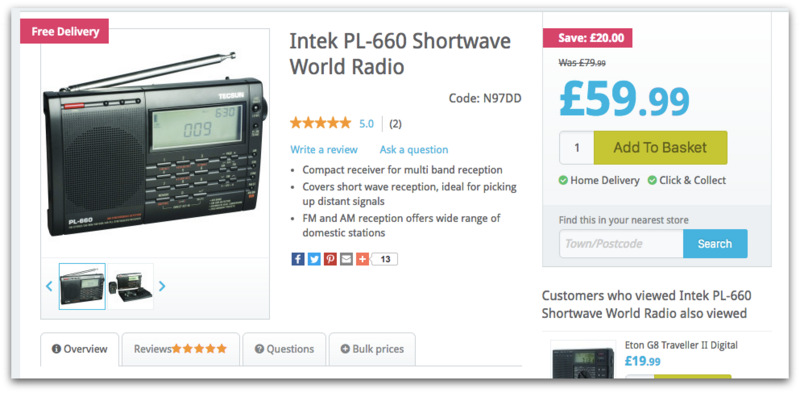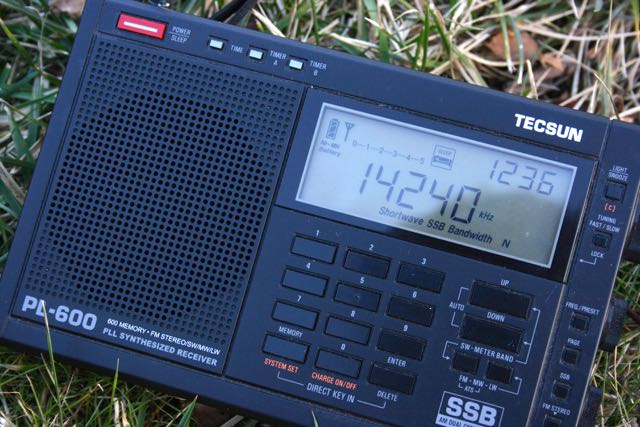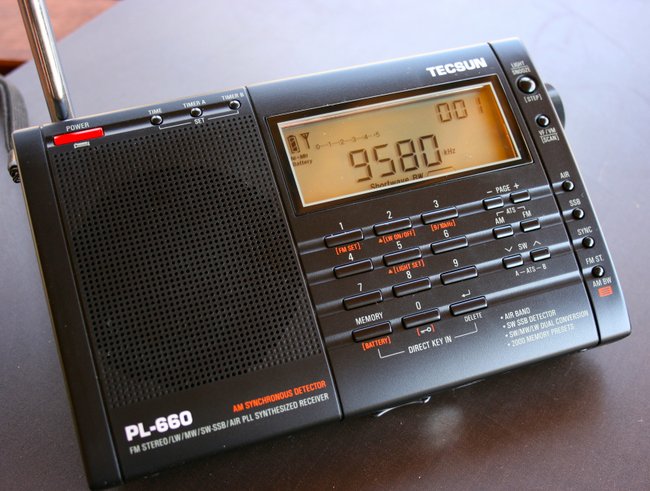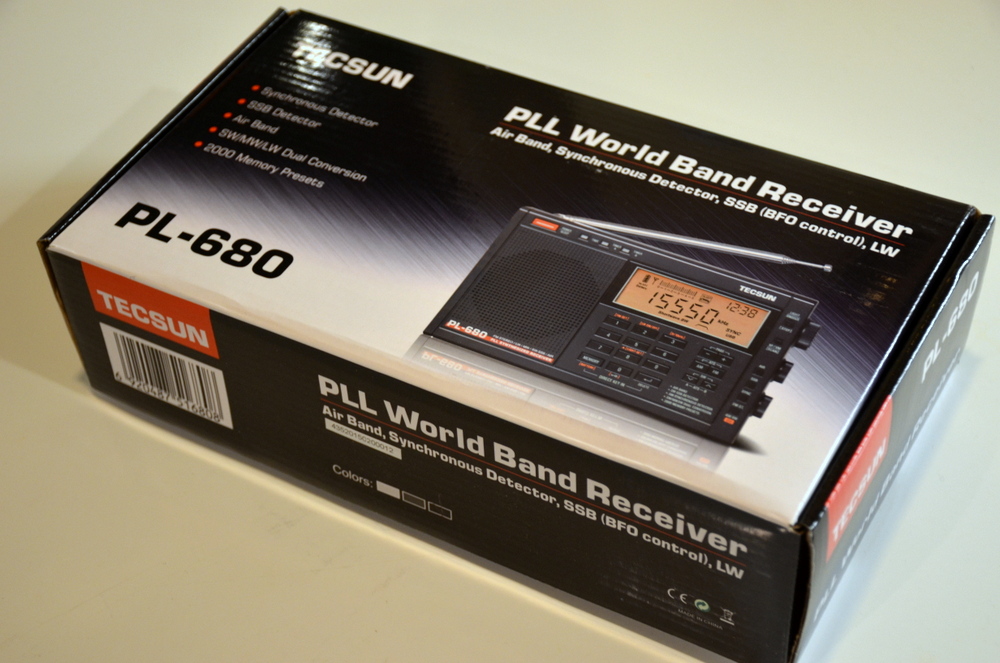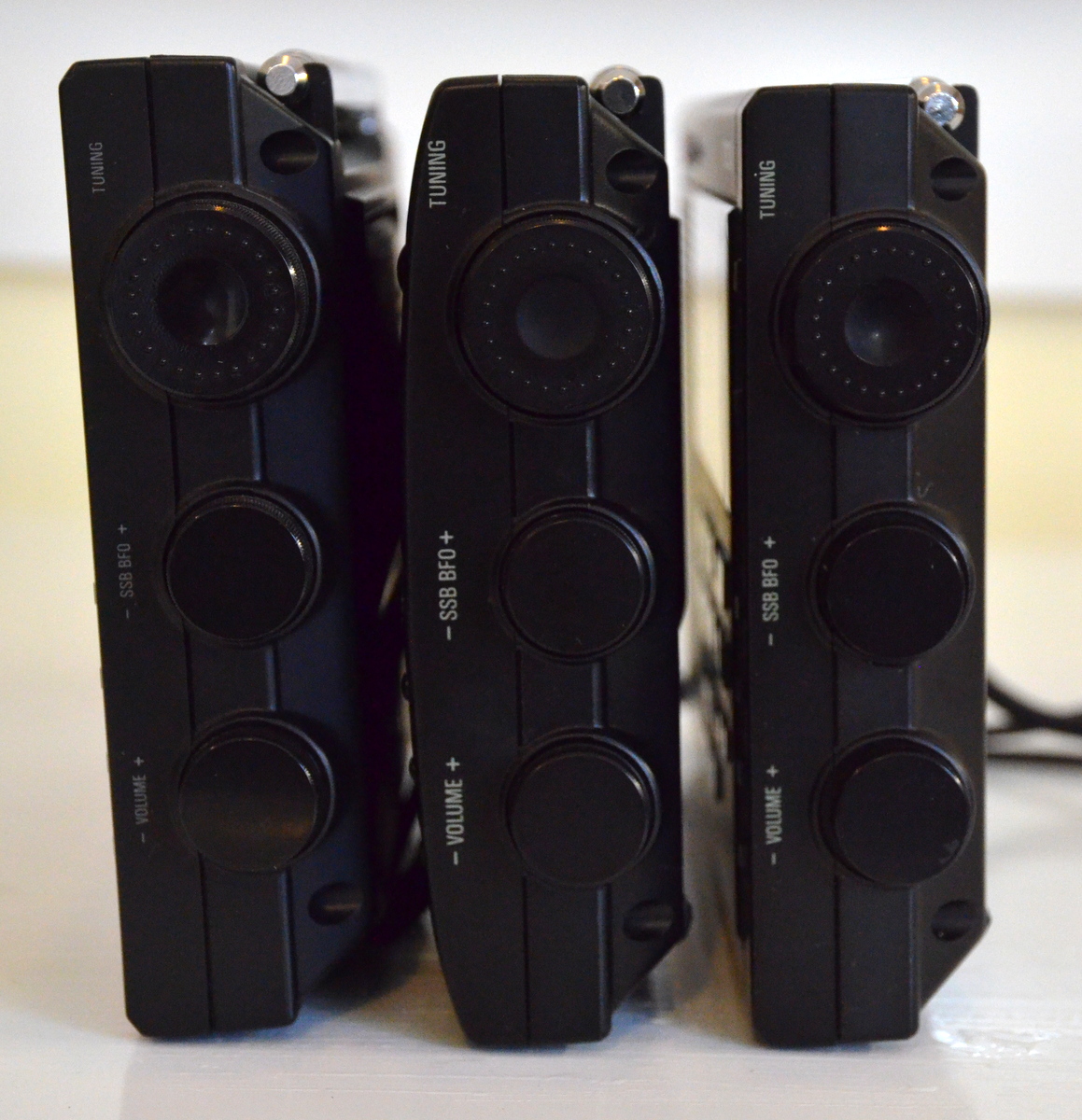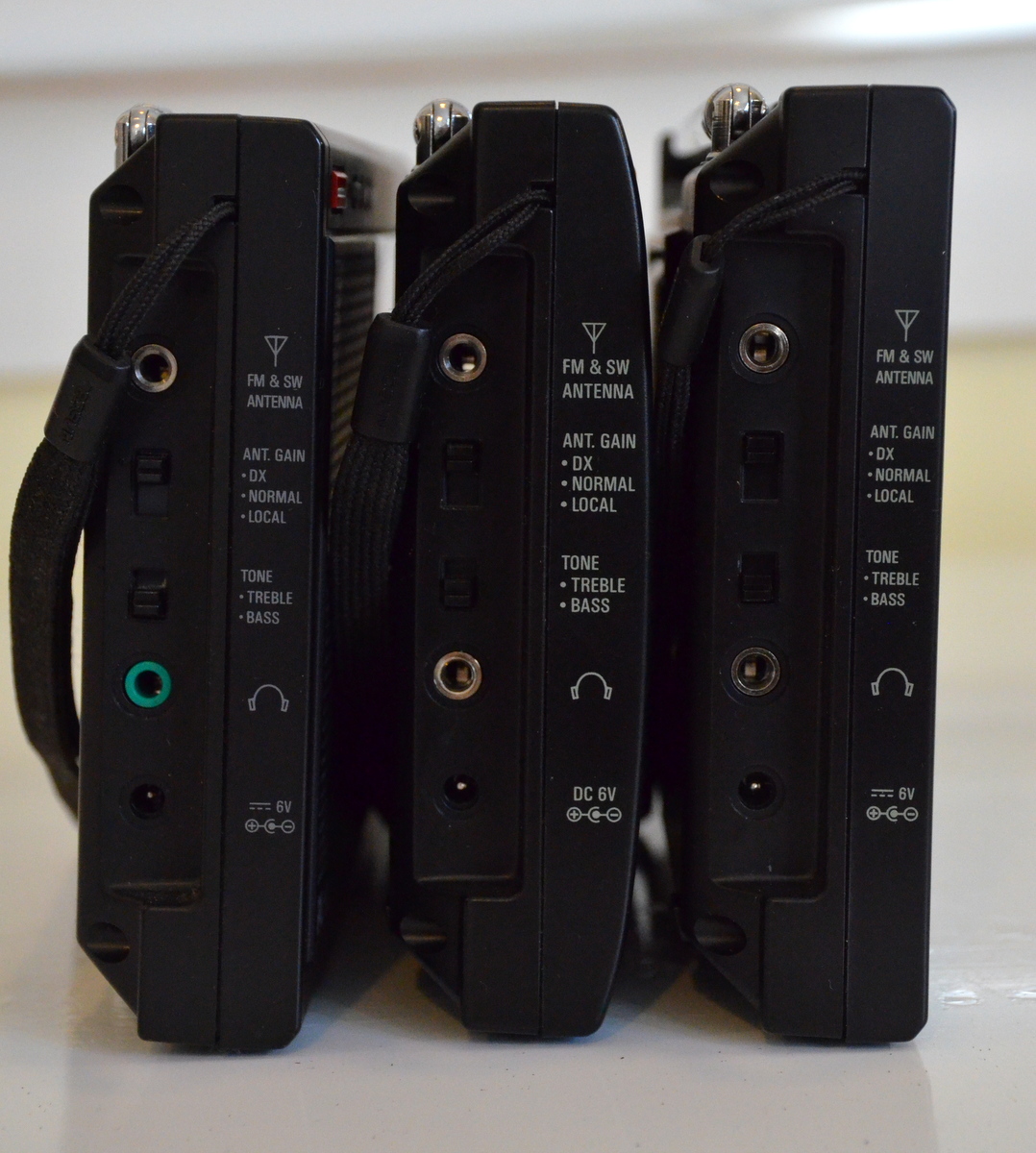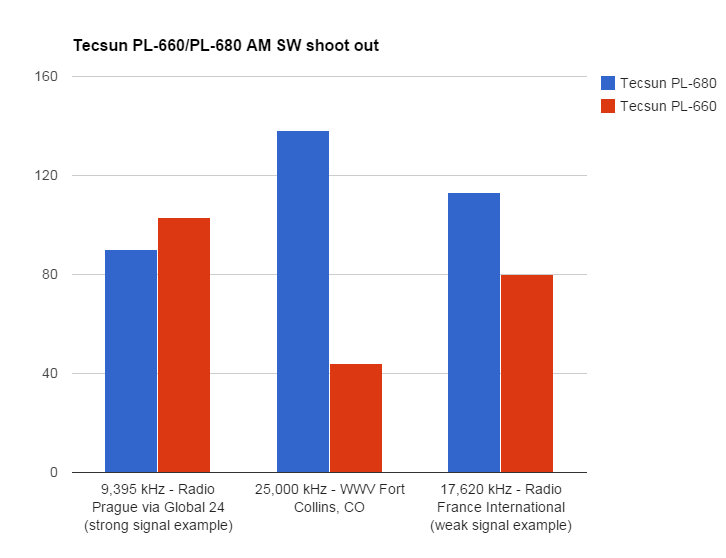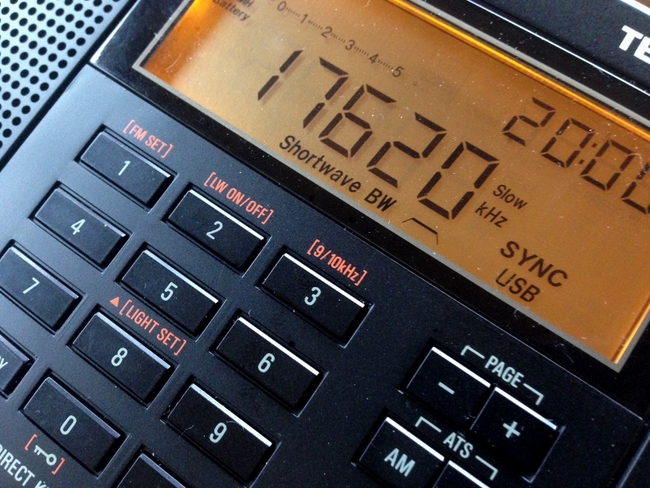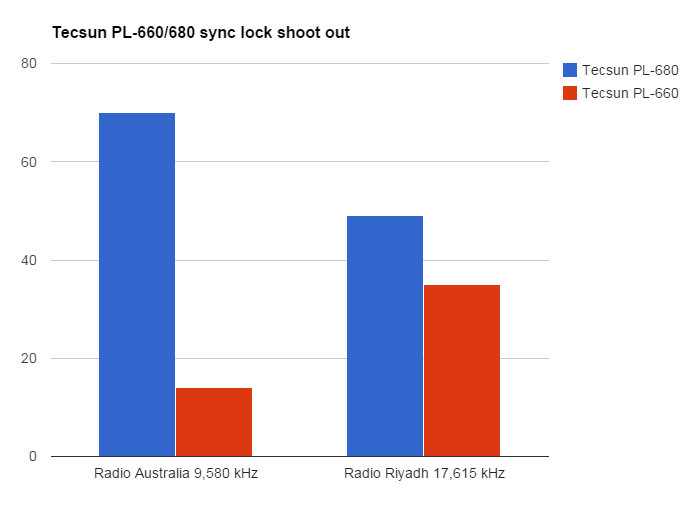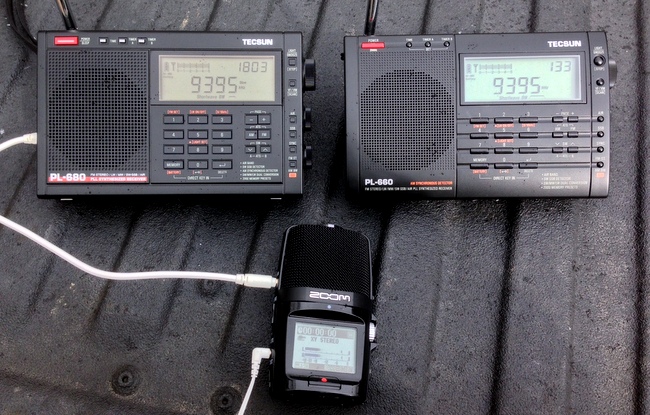If you live in the UK, you might take note that the retailer, Maplin, has the Intek PL-660 on sale for 59.99 GBP. Though I’ve never held an Intek PL-660 in my hands, I’m pretty certain it’s simply a rebadged Tecsun PL-660. (Readers, please correct me if I’m wrong.)
Tag Archives: PL-660
Which one: The Tecsun PL-660 or the PL-600?
This morning, I received a question I’m often asked. It usually goes something like this:
“Should I purchase the Tecsun PL-600, or invest a little more and purchase the Tecsun PL-660? Is it worth the price difference?”
I decided it best to post this question, along with my response, below.
SWLing Post reader, Warren, writes:
“I have been on your web site for a couple of hours now. I especially appreciated your super review. From that I decided I liked the Tecsun PL-660 best. As I was looking for one on ebay, I saw an ad for a Tecsun PL-600. Although I did find specs on your web site, I did not find a review by you. I did find links to other reviews.
One person said a PL-600 was a PL-660 minus the AIR band.
Another said the SSB didn’t work until he took it apart and replaced a capacitor.
Another said the filters didn’t work as well on the 600, or didn’t exist.
Many said the quality was excellent – buy it! Many said it was terrible.
Can you tell me, in your opinion, which, if any, of the above you agree with? And give me your own rating of the 600?
The 600 is much less expensive than the 660. If it is missing filters and sound quality I’m not interested. If it is only missing the airline band I am very interested.”
Here’s my reply to Warren:
“It is confusing and, you’re right, for some reason I don’t think I’ve ever done my own review of the PL-600–though it’s been included in comparisons.
Here’s my answer to your question:
If you want the best overall performance, go for the Tecsun PL-660. I think it’s well worth the price.
The PL-660 has a great synchronous detector–something the PL-600 lacks–which helps with selective fading and pulling weak signals out of the murk. Since you can select the sideband for the sync lock, you can also use this function to help mitigate adjacent signal interference.
Don’t get me wrong: the Tecsun PL-600 is a great radio in its own right. Of the sub-$100 portables [currently $96 shipped via Amazon, $89.95 plus shipping via Universal Radio], it’s one of my favorites.
The ‘600 is one of the few portables on the market in this price range that has a BFO for single sideband listening (along with the CountyComm GP5/SSB and the Degen DE1103 DSP). When newcomers to the hobby want a full-featured sub-$100 radio that’s simple to operate, I often suggest the PL-600. I’ve never had any issues with my PL-600, by the way–it performed as specified right out of the box and continues to do so today.
But again, if one’s budget allows I always recommend the Tecsun PL-660. In my opinion, the ‘660 offers the best performance and features for the price [currently $109.95 plus shipping at Universal Radio, $119.99 shipped via Amazon].
At home, I believe I actually reach for the PL-660 more often than I do my pricier PL-880.
In a nutshell? Your hunch is right. Get the Tecsun PL-660.”
Readers: Do you agree or disagree? Feel free to comment!
Danny’s Tecsun PL-660 still works after a serious mishap
In response to our Mega Review, Danny Bower comments:
Fantastic review and whilst I know the article is an older one people will still read it when looking at a portable SW radio.
With this in mind I would like to make the following comment about the PL660. You say it is bulletproof and boy is it! Mine has been dropped, kicked and overwise abused and it’s still going strong.
Most remarkably it was knocked into a bucket of water, plugged in and powered up and was there for a good couple of hours fully submerged before I realised.
It wasn’t long good for a week or two but after 3 or 4 weeks I have it one last try before binning it and hey presto it came back to life! Ok the volume pot is now a bit scratchy but other than that it’s working just fine.
Want a radio that will take the general abuse of travelling – this is it…
Wow! Thanks for your comment, Danny! Most impressive that your PL-660 went diving that long and lived to tell the tale. Thanks for sharing!
A review of the Tecsun PL-680 with reader survey results
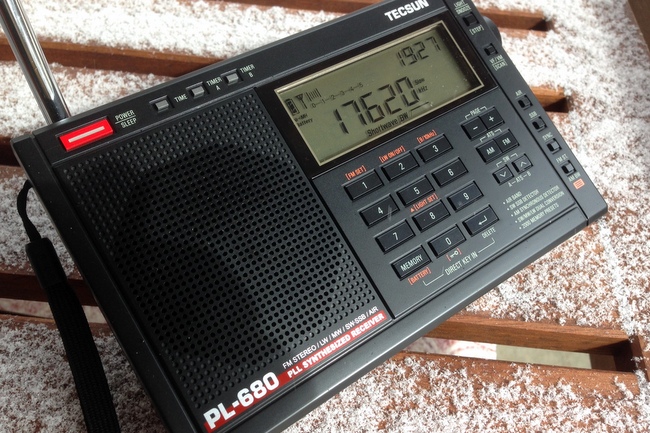 When I heard early reports about the new Tecsun PL-680, I was already wondering how it would stack up alongside other Tecsun portables. An early photo of the Tecsun PL-680 revealed how very similar it is, indeed, to the Tecsun PL-600, which has been on the market for many years. Moreover, the features of PL-680, which I heard about only a few weeks ago, sounded to me like a carbon copy of the venerable PL-660. I investigated further, and spoke with Anna at Anon-Co; she was given to understand that the Tecsun PL-680 was essentially a re-packaged PL-660 with improved sensitivity. I was curious enough about the PL-680 that I ordered one from Anna as soon as they were available, even paying for expedited shipping in order to have it in hand a bit sooner.
When I heard early reports about the new Tecsun PL-680, I was already wondering how it would stack up alongside other Tecsun portables. An early photo of the Tecsun PL-680 revealed how very similar it is, indeed, to the Tecsun PL-600, which has been on the market for many years. Moreover, the features of PL-680, which I heard about only a few weeks ago, sounded to me like a carbon copy of the venerable PL-660. I investigated further, and spoke with Anna at Anon-Co; she was given to understand that the Tecsun PL-680 was essentially a re-packaged PL-660 with improved sensitivity. I was curious enough about the PL-680 that I ordered one from Anna as soon as they were available, even paying for expedited shipping in order to have it in hand a bit sooner.
The Tecsun PL-660 has been on the market for several years now; it’s one of the most popular shortwave portables on the market. And for good reason: the PL-660 is relatively inexpensive, simple to use, packs all of the most vital and desirable functions/modes, and is available from a variety of retailers that ship worldwide. I have reviewed it numerous times and often used it as the basis for comparison with other shortwave portables. It’s China-based manufacturer, Tecsun, has emerged over the past few years as the dominant manufacturer of shortwave radios.
First impressions
I posted a few unboxing photos the day I received the PL-680.
The Tecsun PL-680 looks like the Tecsun PL-600 body, with the Tecsun PL-660 features and layout. Indeed, the full complement of buttons, switches and dials are identically positioned to those of the PL-660.
Let’s cut to the chase…
Question: So, does the PL-680 have more functions than the PL-660?
Answer: No. It appears to be, and likely is, identical in every (functional) respect to the Tecsun PL-660. No surprises here, unless there are hidden features I haven’t discovered…!
Check out the following comparison photos–the PL-600 on the right, PL-660 in the middle, PL-680 on the right (click to enlarge):
The similarity is so striking, in fact, that I believe the PL-680 is the first radio I’ve ever turned on for the first time, only to find I immediately knew every function. I’m so familiar with the PL-660 that I could even use the PL-680 in the dark the first night I used it.
It also helps, of course, that the PL-680 is nearly identical to the PL-600, too, which I’ve owned for many years.
Here’s how I see the PL-680 product development equation:
In truth, I was quite disappointed that Tecsun did not add a line-out jack to the PL-680.
The PL-660, alas, lacks line-out, and though my Tecsun PL-880 has a line-out, its default shortwave volume is simply too high to be used by most digital recorders. I had hoped that the PL-680 might have a proper line-out jack, potentially making it a replacement for my trusty Sony ICF-SW7600GR. Unfortunately, this is not the case.
But other than missing a line-out jack, I really have few complaints. I’ve always been a fan of simple radio design and I believe Tecsun has done a good thing by keeping the user experience so similar in their PL-6XX line of portable shortwave radios. Apparently, a good thing is a good thing.
But here’s what everyone wants to know…
Question: Does the PL-680 have any performance advantages over the PL-660?
Short Answer: Yes! (But keep your PL-660.)
I should add here that I’m about to get rather technical and radio-geeky, so if you’re only interested in a summary, please skip to the bottom of the page.
Otherwise, help yourself to a cup of coffee, and let’s talk radio…
Shortwave performance
Since I spend 95% of my listening time on shortwave, I’ll begin with shortwave performance. Again, we’ll compare the PL-680’s performance with that of the PL-660.
Reader survey results
Having had such great results from radio comparison shoot-outs in the past (check out our shoot-out between top portables and ultra-compact radios), I decided it would make sense to invite our informed readership to evaluate the PL-680’s performance in a series of blind, informal tests. (For information about these surveys, please read through the first of the three surveys.)
Shortwave AM broadcast listening
In most circumstances, you’ll find that the PL-680 has better sensitivity than the PL-660. It’s a marginal improvement, but one I certainly notice on the shortwave bands–and so did the majority of readers who participated in the shortwave AM reception survey.
The survey had recordings from a total of three broadcasters: Radio Prague, WWV, and Radio France International.
The PL-680 was “Radio A,” and the PL-660 was “Radio B.”
The Radio Prague recording was quite strong and was the only broadcast in our survey in which the PL-660 and PL-680 ran neck-and-neck.
In truth, I believe strong signal reception on both these radios is excellent and nearly indistinguishable from each other.
Survey results from the WWV and Radio France International recordings showed a strong preference for the Tecsun PL-680. Again, here are the original recordings:
Based on comments from those who participated, the PL-680 came out ahead of the PL-660 in two respects: better sensitivity, and more stable AGC. In both sets of recordings, the signal was weaker than the Radio Prague recording, and QSB (fading) more pronounced. Herein lies a well-known weakness of the PL-660: soft muting and a sometimes over-active AGC equates to more listening fatigue.
Here is a chart with the full survey results based on 194 listener reports. The number of responses are represented on the vertical axis.
Obviously, the engineers at Tecun addressed the soft muting/AGC problem of the PL-660. In all of my time with the PL-680 on the air, I haven’t noticed any soft muting; the audio has been smooth and the AGC copes with fading much better than the PL-660. No doubt, these two improvements alone make the PL-680 a worthy portable for shortwave radio listening.
There is a downside to the improved sensitivity, however: the PL-680 has a slightly higher noise floor than the PL-660. This is mostly noticeable during weak-signal listening. Though I haven’t compared it yet, I’m willing to bet that the noise floor is comparable to that of the Sony ICF-SW7600GR. Personally, if increased sensitivity and stability means a slightly higher noise floor, I’m okay with that. I find that I listen better when the signal is stable and not fluttering/muting with every QSB trough.
Synchronous detection
The second survey focused on synchronous detection, which is a very useful receiver tool that mitigates adjacent signal interference and improves a signal’s stability. Perhaps it was my good fortune that the same day I tested synchronous detection, fading on even strong stations was pronounced at times. Perfect!
The first recording set was from Radio Australia, a relatively strong signal here in North America. Still, QSB was pronounced–making for an unstable signal–and there was hetrodyne interference in the upper sideband of the broadcast. When I switched the radios into lower sideband sync, halfway through, it effectively mitigated the hetrodyne in all of the recordings.
PL-680 – 1st recording Radio Australia
PL-660 – 1st recording Radio Australia
PL-680 – 2nd recording Radio Australia
PL-660 – 2nd recording Radio Australia
The second set of recordings were of Radio Riyadh–a much weaker station–also affected by QSB:
PL-680 – 1st recording Radio Riyadh (wide band filter)
PL-660 – 1st recording Radio Riyadh (wide band filter)
PL-680 – 2nd recording Radio Riyadh (narrow band filter)
PL-660 – 2nd recording Radio Riyadh (narrow band filter)
While I have always considered the PL-660 to sport one of the stronger sync locks in current production portables, it did truly struggle to maintain a lock in both the Radio Australia and Radio Riyadh recordings. Indeed, I was so surprised by how comparatively feeble the sync lock was on Radio Australia, that I disconnected the PL-660 from the recorder and moved to a different location to verify that something nearby wasn’t causing the sync lock instability. It was not; it was solely due to unstable band conditions.
It came as no surprise that survey respondents took note of the PL-680’s stronger sync lock: the PL-680 beat the PL-660 by a wide margin in both sample recordings. I chart the results, below, from a total of 85 responses:
Very good, PL-680! Someday I’d like to compare the PL-680 with the Sony ICF-SW7600GR, which I’ve always considered to have, among current portables, the strongest sync lock.
Single Sideband
I wasn’t able to provide an audio survey of SSB performance since the PL-680 picked up too much noise from my digital recorder to make for a fair contest.
Meanwhile, I’ve spent time listening to both radios in SSB mode and comparing the models. To my ear, both are very close in SSB performance, but again the PL-680 does have a slight edge on the PL-660 in terms of sensitivity and AGC performance.
SSB audio fidelity is very similar in both radios.
FM Performance
While I haven’t spent more than, let’s say, an hour with the PL-680 on the FM band, I have concluded that it is very sensitive–able to receive all of my benchmark local and regional FM stations.
An informal comparison between thePL-680 and the PL-660 also leads me to believe that they are both excellent FM performers and seemed to compare favorably. I would certainly welcome FM DXers to comment with their own evaluations of the PL-680.
Medium Wave Performance
I’ve also posted a medium-wave listener survey since many of you asked that I provide an evaluation of the medium-wave band.
In short, here is where the PL-680 loses to the PL-660: whereas, on the shortwave bands, the PL-680 is more sensitive, it lacks the same sensitivity on the medium-wave bands.
Though I believe the PL-680 does a marginally better job than the PL-660 of handling the choppy conditions of nighttime MW DX, the PL-660 still pulled voices and music out of the static and made them noticeably more intelligible.
The survey result swung very hard in favor of the PL-660, which has long been one of the more notable medium-wave performers among shortwave portables.
I provided a total of four sample broadcast recordings for comparison. Below, I have embedded one of them–a recording of 940 AM in Macon, Georgia, for your reference.
You can listen to all four recordings in the original survey (again, note that Radio A is the PL-680, B is the PL-660).
Survey results were definitive, with a total of 116 responses:
In all but the strong station sample (750 AM – WBS Atlanta), the PL-660 was preferred by a wide margin.
Summary
Invariably, all radios have strengths and weaknesses; here is a list of my notes from the moment I put the Tecsun PL-680 on the air:
Pros:
- Excellent sensitivity and selectivity on the shortwave bands
- Improved weak signal stability over the PL-660
- Stable sync lock
- Proven PL-600 form factor with good overall ergonomics
- Great internal speaker–an improvement over the PL-660 (but not as good as the PL-880 or Sangean ATS-909X)
- Other than medium-wave performance (see con), a worthy replacement for the PL-660
- Excellent audio from the PL-680 internal speaker (improved over the PL-660, but not matching the fidelity of the PL-880)
Cons:
- Medium-wave performance for is a step backwards from the PL-680’s predecessor, the PL-660. Okay on strong and moderate-signal reception, somewhat poor for weak signals
- Marginal noise floor increase on the shortwave bands
- Like the PL-660, lacks a line-out jack (Please note this, Tecsun!)
- SSB frequency display on my unit is + 1 kHz, slight BFO adjustment is needed (details in this update)
Conclusion
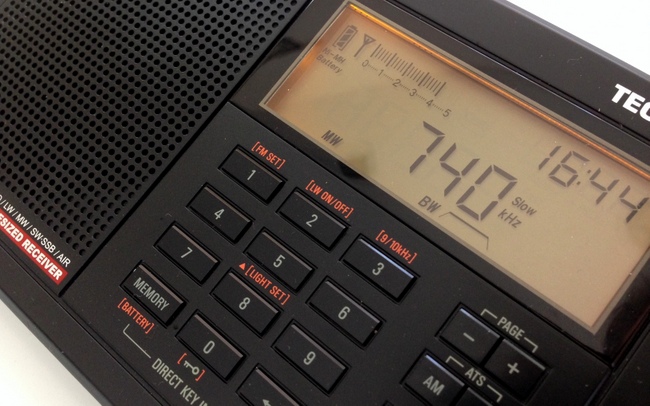 If you’re a shortwave radio listener, you’ll be pleased with the Tecsun PL-680. In all of my comparison tests between the Tecun PL-660 and Tecsun PL-680, the PL-680 tends to edge out the PL-660, performance-wise. This coincides with the user surveys, too.
If you’re a shortwave radio listener, you’ll be pleased with the Tecsun PL-680. In all of my comparison tests between the Tecun PL-660 and Tecsun PL-680, the PL-680 tends to edge out the PL-660, performance-wise. This coincides with the user surveys, too.
If you’re a medium-wave DXer, you might skip over the PL-680. That is, unless Tecsun makes a good iterative design improvement. If you’re a casual medium-wave listener, on the other hand, you’ll probably be pleased with the PL-680.
All in all, I like the Tecsun PL-680 and I see myself using it more than the PL-660 when I’m on the go. If you’re primarily a shortwave radio listener, the PL-680 may very well be worth the upgrade. At $95 US plus shipping, it is certainly a good value. Note that Anon-Co plans to post the Tecsun PL-680 for sale on eBay in March 2015.
Click here to find the PL-680 on eBay.
Addendum:
- PL-680 calibration: Dennis Coomans confirms via Anon-Co that the PL-680 (like the PL-660) can be calibrated by long pressing the AIR button (for SW, AM, etc) and by pressing SYNC for FM. According to Anon-Co, “all PL-680 receivers from production lines after November 2017 have this (hidden) manual calibration feature.”
Tecsun PL-680: Reader surveys closing today
If you haven’t had a chance to weigh in on the Tecsun PL-660/PL-680 comparison surveys, you will need to do so by 23:00 UTC today.
I’m working on the Tecsun PL-680 review and need completed surveys for graphs/charts. The review should be posted this weekend.
If you haven’t voted yet, here are links to each receiver survey with comparative audio samples:
Responses for these surveys has been, quite frankly, amazing! At time of publishing this post, we’ve received 367 individual survey responses! Thank you!
Reader Survey: Comparing the Tecsun PL-680 and PL-660 on medium wave (AM)
[Update: Please note that this survey has been closed, but the audio samples–labeled Radio A and Radio B–will remain to allow others the opportunity to make an evaluation prior to reading the PL-680 review.]
[Update 2: The PL-680 review and readers’ survey results have now been posted! Check it out here.]
The results from the PL-680/PL-660 reader surveys (here and here) have been pouring in! As of this posting, well over 200 readers have participated by listening to and evaluating the two receiver comparison surveys. Thank you!
Yesterday evening, I spent time comparing the Tecsun PL-660 and PL-680 with medium wave reception in mind. I recorded dozens of samples and picked four broadcast recordings I felt best represented receiver performance. Note that this will be my final survey before I post the PL-680 review later this week.
If you’re not familiar with these readers surveys, please read our first post, as it contains all of the vital info and disclaimers.
To participate in this survey, start by simply listening, then fill out the form that follows with your choice of “Best Radio” for each broadcast. All of these medium wave samples were recorded in the evening hours, which I believe is more indicative of receiver sensitivity, selectivity and AGC. Notice that I indicate distance to target station (as the crow flies).
Audio Samples
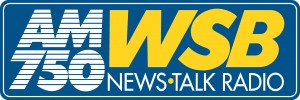 750 AM – WSB Atlanta, Georgia, USA (171 mi/275 km)
750 AM – WSB Atlanta, Georgia, USA (171 mi/275 km)
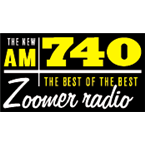 740 AM – CFZM Toronto, Canada (580 mi/933 km)
740 AM – CFZM Toronto, Canada (580 mi/933 km)
 940 AM – WMAC Macon, Georgia, USA (204 mi/328 km)
940 AM – WMAC Macon, Georgia, USA (204 mi/328 km)
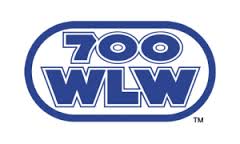 700 AM – WLW Cincinnati, OH, USA (271 mi/436 km)
700 AM – WLW Cincinnati, OH, USA (271 mi/436 km)
Submit your response
Click here to use our response form to vote on your favorites, or simply use the form embedded below:
I’ll leave all PL-660/PL-680 comparison surveys open for evaluation until I publish the Tecsun PL-680 review.
Reader Survey: Comparing the Tecsun PL-680 and PL-660 synchronous detection
[Update: Please note that this survey has been closed, but the audio samples–labeled Radio A and Radio B–will remain to allow others the opportunity to make an evaluation prior to reading the PL-680 review.]
[Update 2: The PL-680 review and readers’ survey results have now been posted! Check it out here.]
The results from the PL-680/PL-660 reader survey have been pouring in! As of this posting, over 160 readers have participated by listening to and evaluating the AM shortwave audio samples. Thank you!
This morning, I spent time comparing the Tecsun PL-660 and PL-680 with synchronous detection in mind. Time permitting, I hope to publish at least a medium wave audio survey, too, before I post the PL-680 review later this week. I doubt I will post an SSB reception survey since my digital recorder injects a bit of noise into those recordings.
If you’re not familiar with these readers surveys, please read our previous post, as it contains all of the vital info and disclaimers.
To participate in this survey, start by simply listening, then fill out the form that follows with your choice of “Best Radio” for each broadcast. Please note that I include two recordings per broadcast, but ask that you choose the best radio overall for each broadcast.
For example: if you feel that Radio A is better in the first recording of Radio Australia, but Radio B is slightly better in the second recording (again, of Radio Australia), you still need to chose which radio is best overall in the Radio Australia recordings set.
You’ll note that signal stability varies between the two recordings; this is simply the nature of shortwave radio. Also note that each recording was made within one minute of the other in each set.
Audio Samples
Radio Australia 9,580 kHz
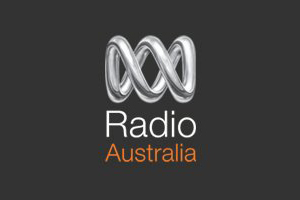 Below I’ve provided two recordings of Radio Australia on 9,580 kHz. In both recordings, I have the PL-660 and PL-680 in normal AM mode for the first half of the recording–you will hear a het (hetrodyne–which sounds like a high-pitch tone) in the upper sideband. About halfway through the recording, I switch each radio into lower sideband sync, which effectively removes the het sound.
Below I’ve provided two recordings of Radio Australia on 9,580 kHz. In both recordings, I have the PL-660 and PL-680 in normal AM mode for the first half of the recording–you will hear a het (hetrodyne–which sounds like a high-pitch tone) in the upper sideband. About halfway through the recording, I switch each radio into lower sideband sync, which effectively removes the het sound.
I have provided two recordings for each radio since QSB (fading) was fast and deep. Indeed, you’ll note in the second set of recordings that the radios had more difficulty maintaining the sync lock.
Radio Riyadh 17,615 kHz
 Radio Riyadh could certainly be considered weak-signal listening this morning, though their opening on 16 meters was quite good for the time of day.
Radio Riyadh could certainly be considered weak-signal listening this morning, though their opening on 16 meters was quite good for the time of day.
In the recordings below, I start in AM mode, then switch the radio to USB sync after 15 seconds, and to LSB sync after 30 seconds.
In the first set of recordings both radio’s filters are set wide; in the second set, narrow.
First Recording: Radio A – (wide band filter)
First Recording: Radio B – (wide band filter)
Second Recording: Radio A – (narrow band filter)
Second Recording: Radio B – (narrow band filter)
Submit your response
Click here to use our response form to vote on your favorites, or simply use the form embedded below:
I’ll leave all PL-660/PL-680 comparison surveys open for evaluation until I publish the Tecsun PL-680 review.

